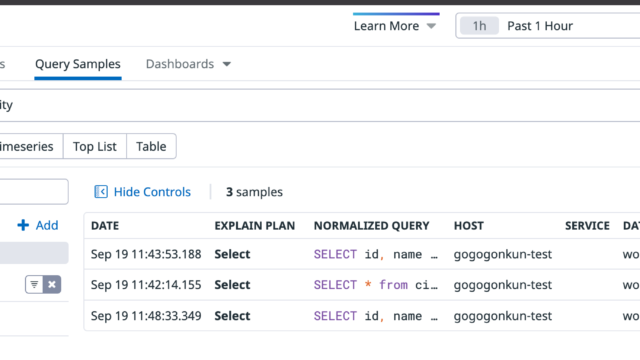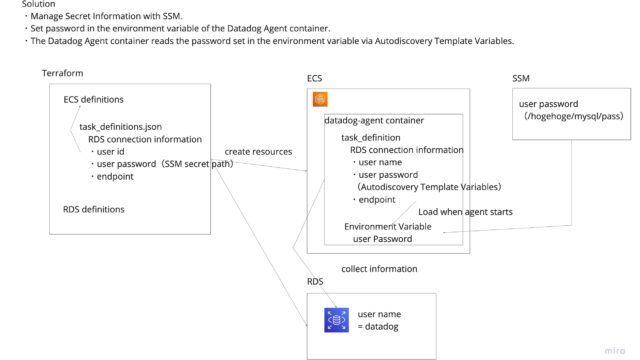While working through "Web Performance Tuning by Experts," I tried to identify and improve bottlenecks in a sample application.
Here’s a brief introduction to the workflow and commands I used.
If you want to learn more about the detailed thought process for bottleneck investigation and performance improvement, I recommend getting the book mentioned above.
Target Audience
- People who want to know the basic workflow for web performance testing
- People looking for useful commands to use during performance testing
What I Did
The basic workflow was as follows:
- Preparation
- Configure log output settings to check execution results
- Execute load testing
- Apply load using a benchmarking tool
- Monitor the system during load testing
- Check execution results to identify bottlenecks
- Perform tuning
Preparation
Complete log output configuration and command installation.
If you’ve followed the environment setup articles below, you should be ready to go.
https://gonkunblog.com/web-performance-handson-1/1268/
https://gonkunblog.com/web-performance-handson-2/1289/
Load Testing Execution
Apply load using a benchmark tool (I used the ab command introduced later).
During load testing, I monitored the system resource usage with commands like top and dstat.
- Is the CPU idle?
- Which part is becoming a bottleneck where requests are piling up?
I was monitoring with these types of questions in mind.
Bottleneck Investigation
After the load test is complete, examine the logs to identify bottlenecks.
For a simple web application configuration, you would typically check the following items first:
- Check the web server access logs
- Check SQL execution results (SlowQuery logs)
- Compare with system resource usage
If performance isn’t improving even though the system isn’t under heavy load (CPU isn’t maxed out), you should suspect bottlenecks somewhere in the process. There are several standard perspectives to consider.
The book introduces several perspectives which I found useful.
Performance Improvement
Here’s what I implemented within the scope of what could be fixed immediately:
- Adding indexes to database tables
- This alone increased throughput about 50 times
- Increasing the number of web server workers
- The CPU was underutilized
- When increasing request parallelism from 1 → 2 → 4, the wait time per request increased linearly
- After confirming the above conditions, I suspected that there were too few web server workers
For this kind of work, you need to accumulate experience and expand your toolkit.
Useful Commands
I’ve compiled command templates that are useful for bottleneck investigation and performance improvement.
Access Log Analysis – alp command
This can be used to analyze nginx access logs.
GitHub: https://github.com/tkuchiki/alp
Aggregation targets:
timemethoduristatusresponse_timerequest_time
# Simple usage
cat access.log | alp json
+-------+-----+-----+-----+-----+-----+--------+----------------------+-------+-------+-------+-------+-------+-------+-------+--------+-------------+-------------+-------------+-------------+
| COUNT | 1XX | 2XX | 3XX | 4XX | 5XX | METHOD | URI | MIN | MAX | SUM | AVG | P90 | P95 | P99 | STDDEV | MIN(BODY) | MAX(BODY) | SUM(BODY) |AVG(BODY) |
+-------+-----+-----+-----+-----+-----+--------+----------------------+-------+-------+-------+-------+-------+-------+-------+--------+-------------+-------------+-------------+-------------+
| 1 | 0 | 1 | 0 | 0 | 0 | GET | /favicon.ico | 0.000 | 0.000 | 0.000 | 0.000 | 0.000 | 0.000 | 0.000 | 0.000 | 43.000 | 43.000 | 43.000 | 43.000 |
| 1 | 0 | 1 | 0 | 0 | 0 | GET | /css/style.css | 0.000 | 0.000 | 0.000 | 0.000 | 0.000 | 0.000 | 0.000 | 0.000 | 1549.000 | 1549.000 | 1549.000 | 1549.000 |
| 1 | 0 | 1 | 0 | 0 | 0 | GET | /img/ajax-loader.gif | 0.004 | 0.004 | 0.004 | 0.004 | 0.004 | 0.004 | 0.004 | 0.000 | 673.000 | 673.000 | 673.000 | 673.000 |
# Add -r for descending order. Sorts by most accessed URIs
cat access.log | alp json -r
# Use --sort=xxx to sort by specified column. Sort by total response time per URI
cat access.log | alp json --sort=sum -r
# Sort by average response time per URI
cat access.log | alp json --sort=avg -r
# Use -o xxx,xxx, ... to narrow down displayed content
cat access.log | alp json -o count,method,uri,min,avg,max
+-------+--------+-----+-------+-------+-------+
| COUNT | METHOD | URI | MIN | AVG | MAX |
+-------+--------+-----+-------+-------+-------+
| 10 | GET | / | 1.360 | 1.365 | 1.372 |
+-------+--------+-----+-------+-------+-------+
# avg, sum, p99 are commonly used
cat access.log | alp json -o count,method,uri,avg,sum,p99 -r
# To aggregate query parts like '/image/1863.jpg'
cat access.log | alp json -o count,method,uri,avg,sum,p99 -r -m "/image/[0-9]+"
+-------+--------+----------------------+-------+-------+-------+
| COUNT | METHOD | URI | AVG | SUM | P99 |
+-------+--------+----------------------+-------+-------+-------+
| 185 | GET | /image/[0-9]+ | 0.002 | 0.416 | 0.024 |
| 8 | GET | / | 0.089 | 0.712 | 0.256 |
# Find requests with 5xx errors
cat access.log | alp json -o count,method,uri,5xx -r
# If the access log is in default format instead of json
cat access.log | alp regexp
Quite convenient. It might be better than manually grepping through access logs during an incident.
Benchmarking Tool – ab command
You can quickly apply load by specifying concurrency and requests.
Installing the benchmarking tool:
sudo apt update
sudo apt install apache2-utils
# Basic usage
# Send 10 requests with concurrency level 1 to localhost
ab -c 1 -n 10 http://localhost/
# Enable KeepAlive
ab -c 1 -n 10 -k http://localhost/
# Send requests for 30 seconds
ab -c 1 -t 30 http://localhost/
# Don't fail if response size varies between requests. Useful for dynamic pages.
ab -c 1 -t 30 -l http://localhost/
# For POST requests, it's a bit more complex
# Use -p to specify a file containing the POST body
ab -c 1 -t 30 -p ./sample.json -T "application/json; charset=utf-8" "http://localhost/hogehoge"
Good for unit-level testing.
Not suitable when complex scenarios are needed.
# Brief explanation of results
$ ab -c 1 -n 10 http://localhost/
This is ApacheBench, Version 2.3 <$Revision: 1879490 $>
Copyright 1996 Adam Twiss, Zeus Technology Ltd, http://www.zeustech.net/
Licensed to The Apache Software Foundation, http://www.apache.org/
Benchmarking localhost (be patient).....done
Server Software: nginx/1.18.0
Server Hostname: localhost
Server Port: 80
Document Path: /
Document Length: 35644 bytes
Concurrency Level: 1 # Concurrency level
Time taken for tests: 13.651 seconds # Total elapsed time
Complete requests: 10 # Number of successful requests
Failed requests: 0 # Number of failed requests
Total transferred: 360160 bytes # Total bytes transferred from server
HTML transferred: 356440 bytes
Requests per second: 0.73 [#/sec] (mean) # Number of requests processed per second
Time per request: 1365.054 [ms] (mean) # Elapsed time for processing one request
Time per request: 1365.054 [ms] (mean, across all concurrent requests)
Transfer rate: 25.77 [Kbytes/sec] received
Connection Times (ms)
min mean[+/-sd] median max
Connect: 0 0 0.0 0 0
Processing: 1360 1365 3.8 1365 1372
Waiting: 1360 1365 3.8 1365 1372
Total: 1360 1365 3.8 1365 1372
Percentage of the requests served within a certain time (ms)
50% 1365
66% 1366
75% 1367
80% 1369
90% 1372
95% 1372
98% 1372
99% 1372
100% 1372 (longest request)
```
Requests per second: 0.73 [#/sec] (mean) # Number of requests processed per second
Time per request: 1365.054 [ms] (mean) # Elapsed time for processing one request
Throughput and processing time are key metrics to look at.
Slow Query Analysis – mysqldumpslow
Used to aggregate SlowQuery logs.
Comes with MySQL installation, so no additional installation is needed.
# Output sorted by total execution time
sudo mysqldumpslow /var/log/mysql/mysql-slow.log
# Output looks like this
Reading mysql slow query log from /var/log/mysql/mysql-slow.log
Count: 1716 Time=0.05s (77s) Lock=0.00s (0s) Rows=3.0 (5148), isuconp[isuconp]@localhost
SELECT * FROM comments WHERE post_id = N ORDER BY created_at DESC LIMIT N
Even if the execution time of each query is short, if a huge number of queries are executed, the proportion of query execution time in the total processing time can be enormous, so be careful.
You can identify bottleneck causes by examining query execution time, Rows (how many rows were accessed to return n rows), etc.
Monitoring CPU, Memory, Processes – top
You can monitor various metrics.

If you have 2 or more CPU cores, be careful as the meaning of the CPU denominator changes between the upper and lower parts. I often find myself thinking "Wait, which one was it?"
The upper part uses all machine CPUs as the denominator.
The lower part is per CPU core. With many cores in the lower part, the total CPU usage can exceed 100%.
System Metrics Display – dstat
You can easily monitor CPU usage with the dstat –cpu command.
GitHub: https://github.com/dstat-real/dstat
$ dstat --cpu
--total-cpu-usage--
usr sys idl wai stl
4 1 95 0 0
0 0 100 0 0
0 0 100 0 0
0 0 99 0 0
0 0 100 0 0
0 0 100 0 0
15 3 81 0 0
48 9 43 0 0
50 8 42 0 0
48 9 43 0 0
49 9 43 0 0
47 9 44 0 0
49 7 44 0 0
idl: Indicates that the CPU is not processing and is idle.
I've used vmstat until now, but this is quite easier to read.
Development has stopped, and dool is being developed as its successor.
GitHub: https://github.com/scottchiefbaker/dool
Conclusion
I’ve briefly introduced the load testing workflow and a collection of useful commands.
I’ve prepared for load testing with scenarios before, but I learned a lot from simply applying load with the ab command.
That’s all.











